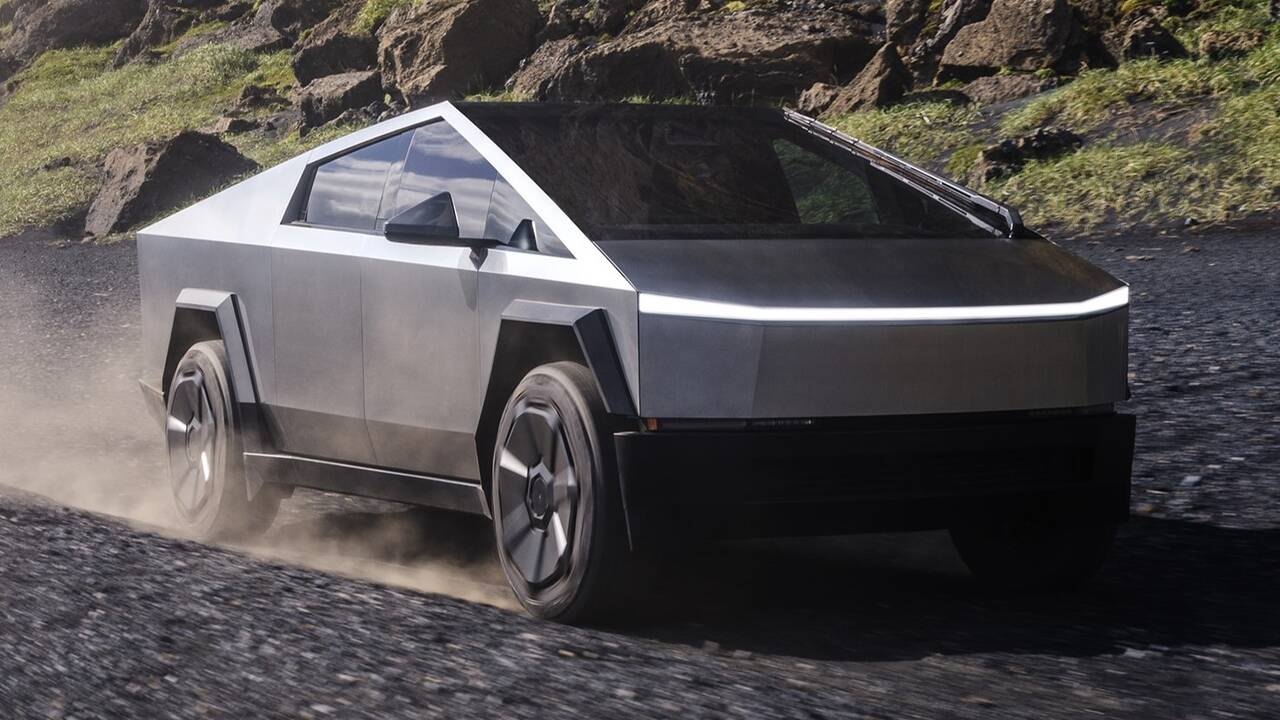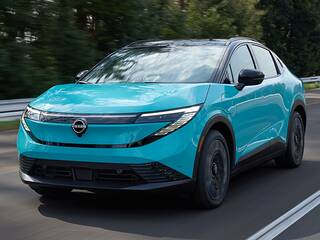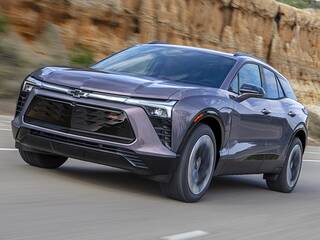Tesla's real problem isn't DOGE or "stale products"
The company's newest model is actually where it all went wrong.

published May 2, 2025

Key Takeaways
- It's hard to find an analysis of Tesla's troubles that doesn't blame dated designs or Elon's dalliance with DOGE.
- But the original sin was Musk's pre-DOGE decision to produce a nonsensical model that should have remained a pipe dream.
Judging by Tesla's stock price, the company's recent struggles were simply a matter of Daddy not spending enough time at home. It's been about a week and a half since wayward CEO Elon Musk announced on his April 22nd earnings call that "I'll be allocating far more of my time to Tesla," and TSLA has shot up from $227.50 per share — the closing price on April 21st — to $287.21 on May 2nd.
That's a 26-percent bounce, largely attributable to the assumption that Tesla will be better off with a fully engaged Musk back at the helm.
So let's test that assumption. No one was raising existential concerns about Musk's lack of focus from, say, the onset of COVID (March 2020) through 2023, before he dived headlong into the 2024 presidential race. If Full-Time Elon is the cure for what ails Tesla, then those must have been great years, right? What does the company have to show for them?
I'll give you some hints: it's pointy like a paper airplane, it's shiny like a fridge, and Tesla still hasn't gotten rid of last year's inventory despite massive discounts that reek of desperation.
Last time Tesla had a fully engaged Musk, in other words, he channeled the enterprise's collective energy into productionalizing a possibly drug-fueled concept that never should have seen the light of day. In the process, untold resources were utilized that could have kickstarted any number of more sensible pursuits.
That unhinged executive decision is the real reason Tesla's up against it, and it's why, far from providing comfort to investors, the prospect of more Musk should be setting off alarm bells about the company's future.
"We dug our own grave with the Cybertruck."
Most of us will have forgotten by now, if we ever knew, that Musk himself uttered those words during a late 2023 earnings call. He had clearly lost much of his signature bravado by that stage of the Cybertruck's development, sounding more like a man who had sobered up and realized the magnitude of his mistake.
To recap, the Cybertruck's grand unveiling in 2019 — the one where chief designer Franz von Holzhausen shattered the driver window's supposedly shatterproof "Tesla Armor Glass" by throwing a steel ball at it on a global livestream — came with promises of a 2021 production launch, a $39,900 base price and up to 500 miles of range. Oh, and it was going to have an "exoskeleton," meaning that rather than having its body welded to a stress-bearing frame like most trucks, the stainless-steel exterior panels would serve as a "stressed skin" that obviated the need for a traditional frame, thus saving weight.
In reality, we had to wait until late 2023 for the first Cybertrucks to be delivered, and these were tri-motor "Cyberbeast" models that retailed for $99,990, joined later by a dual-motor version priced from $79,990. The exoskeleton had bit the dust in the intervening years, replaced by carlike integrated underpinnings akin to the unibody Honda Ridgeline. Although the tri-motor Cyberbeast was supposed to be the one with the 500-mile range, Tesla dropped its estimate to just 320 miles (301 miles with all-terrain tires) for the production version, with the dual-motor Cybertruck checking in at 325 miles (314 with the chunkier tires).
Notably, a $16,000 "range extender" supplemental battery was offered for a while on Tesla's website, accompanied by claims that it could boost the Cyberbeast to 440 miles of range and the dual-motor truck to between 445 and 470. But that option never materialized, and then it disappeared from the site earlier this year, leaving the Cybertruck defenseless against GM's 460-mile Silverado 1500 EV/Sierra 1500 EV twins and the 420-mile Rivian R1T.
Tesla Cybertruck vs. Rivals
Vehicle Range Power 2025 Chevrolet Silverado EV RST Max Range 460 mi 754 hp 2025 Rivian R1T Dual Max 420 mi 533 hp 2025 Tesla Cybertruck RWD 362 mi 315 hp 2025 Tesla Cybertruck Dual Motor AWD 325 mi 600 hp 2025 Tesla Cybertruck Cyberbeast 320 mi 845 hp
Tesla also recently introduced a single-motor, rear-wheel-drive variant rated at up to 362 miles of range, but it's hardly a value play, checking in at the same $69,990 price point that Musk projected for the tri-motor truck in 2019. As for the $39,900 base price he touted for the Cybertruck back then, we can add that to the pile of things that are never going to happen.
Even leaving aside all the sensational reports of Cybertrucks shedding their shoddily glued-on body panels and so forth, it's clear that Musk — who was fully engaged during this period, remember — repeatedly cut corners and broke promises in order to get this thing to market.

And was it worth it in the end? Evidently not. Discussing Cybertruck sales targets in 2023, Musk said that "a quarter million a year is a reasonable guess and it might be 500,000," but Tesla moved just 6,406 units in the first three months of 2025. On an annualized basis, that's barely 10 percent of Musk's "quarter million a year" prognostication.
In short, Tesla's newest model is already facing catastrophic headwinds in its second year of production, and it doesn't seem like the kind of vehicle that's going to pull off a rousing comeback. If you're part of the demographic niche that wanted a Cybertruck, you probably already have one. Elon's grave-digging comment appears, a year and a half later, uncomfortably prescient.
The opportunity cost of building a pipe dream
Although it's fashionable now to call out Tesla's "stale products," the truth is that the non-Cybertruck Teslas never stopped being fully competitive. In particular, the two models that account for about 95 percent of Tesla's sales are perennial all-stars.
To wit, the Model 3 was already the best car in its class before the 2024 "Highland" refresh solidified that status, even though the underlying platform dates to 2017. Similarly, the Model Y — dating to late 2019 underneath — didn't need the 2025 "Juniper" refresh to keep dominating the compact electric SUV segment, although those updates should ultimately help the cause.
The crucial point here isn't staleness, but rather the extent to which the Cybertruck debacle took the company's eye off the ball during that key 2020-'23 period when Musk was giving Tesla his full attention. From a product development standpoint, those are lost years that Tesla's never getting back. A reasonable investor (or board member) might wonder: What if there were no Cybertruck? How different would Tesla look today?

For one thing, the Juniper refresh surely would have launched sooner, and I suspect there would have been a fuller menu of options from the get-go. Right now, for example, there's still no Juniper version of the Model Y Long Range RWD, which was the range and price leader in the pre-refresh lineup. You also can't order a third-row seat yet. That means you can have your Juniper Model Y any way you like, as long as it's a Long Range AWD five-seater. Every day that Tesla keeps fumbling this transition is an opportunity for rivals to gain ground.
But think of the other projects that could have been fast-tracked if Elon's stainless-steel folly hadn't become the top priority. How about a relatively affordable midsize three-row SUV to pit against the Kia EV9, given that the three-row Model X costs nearly $85k? Just start with the Model Y, add 10 inches of length to open up passenger and cargo space, and take some of the bubbliness out of the styling while you're at it. Which idea makes more sense, that or the Cybertruck?
Also, there's no way we'd still be waiting for a cheaper entry-level Tesla to arrive. It would be on the market already, bringing price relief to American shoppers while possibly clawing back some market share in China, where cheaper domestic EVs have been eating Tesla's lunch.
I could go on. The opportunity cost of building the Cybertruck is, of course, the value of the productive activities that Tesla consequently avoided or deprioritized, and those coulda-woulda-shouldas hit especially hard given the truck's dismal sales performance. Tesla's engineers are among the best in the game, but the Cybertruck was a colossal waste of their talents.
And who ultimately greenlit that bonkers allocation of resources? You know it: Full-Time Elon himself.
Mo' Musk, mo' problems?
I don't mean to imply that any and all optimism about Musk's return is irrational. In the pre-Cybertruck era, this man turned a startup tinkering with battery-powered sports cars into a globe-straddling EV giant. Maybe that guy's still in there somewhere — maybe that's the Elon who's about to resume his duties.
But the Cybertruck chapter raises real questions about his ability to lead Tesla as a mature company, to say nothing of his polarizing political antics, which is why it didn't surprise me at all to hear that Tesla's board may be shopping for a better CEO. If Elon ultimately sticks around, Tesla and its stakeholders had better hope that the Cybertruck was an aberration and not a sign of leadership decisions to come. ⛐ md

by Josh Sadlier
Publisher and Donkey-in-Chief
Josh has been reviewing cars professionally since joining Edmunds.com fresh out of grad school in 2008. Prior to founding MotorDonkey, he spent 15 years shaping Edmunds' expert automotive content in various capacities, starting as an associate editor and ultimately serving as a senior editor before wrapping up with a five-year term as the company's first-ever director of content strategy. Josh is a card-carrying member of the Motor Press Guild and a lifelong car nut who has driven, compared and critiqued thousands of cars in his career. Helping people find their perfect car never gets old—seriously!
 Let's make it official!
Let's make it official!
Be a good donkey and we'll deliver delicious car news straight to your inbox, spam-free forever.


